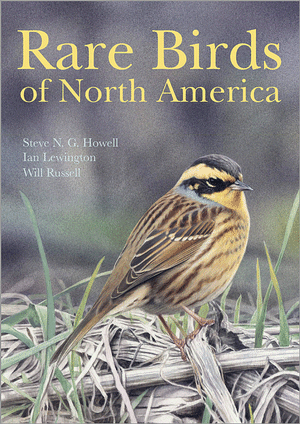I've never met Steve N. G. Howell, but if I had the opportunity I think I might be too intimidated, and beg off with a fake illness or a made-up death in the family. You think you're a good birder? Well, this guy wrote the book on molt. He literally wrote a book about molt.
At a time when most field guide authors are aiming for the sweet-spot middle with general American bird guides, Howell has cast off ornithological (and financial?) conventions and found a niche taking on especially difficult or outlier birding topics: gulls; petrels; hummingbirds; molt. He's a bird guide writer's bird guide writer, someone who seems to feel no need to dumb things down for new birders. He's back at it with Rare Birds of North America, a guide to avian vagrants and vagrancy.
It's mouthwatering ground to cover. Howell, along with coauthors Ian Lewington and Will Russell, cover 262 species of American vagrants, detailing their plumage and habits, of course, but more importantly the potential reasons behind their vagrancy patterns. In fact, the "Migration and Vagrancy in Birds" chapter at the beginning is worth the sticker price all by itself. For hardcore birders, it's the kind of book that makes you want to stop reading, and I mean that in a good way.
But it ain't perfect. As with some of Howell's other titles, especially Gulls of the Americas, it's organized fairly unhelpfully. [A quick note on Gulls of the Americas: can we please get a reworked and updated edition? No group needs a comprehensive ID guide more than gulls, but GotA needs a lot of fixing. My two cents: better photos (with illustrated plates for guidance), better organization, and drop the South American birds.] In Rare Birds, species are broken up into groups, such as Wading Birds or Aerial Landbirds, and then those groups are typically broken up again into those species originating in the Old World and the New World. The effect of the New World/Old World split is disorienting - for example, there are sections of flycatchers separated by 58 pages of Old World robins, warblers and wagtails - without being useful. Additionally, the book lacks usefulness as an identification guide because of its sparse treatment, both in plates and in print, of "similar species."
Rare Birds of North America continues Howell's brave exploration into areas of birding heretofore unknown in print. Though this book is imperfect, and will likely become outdated as a reference as new records pile up, it's a bold examination of the science behind vagrancy, and will hopefully push some birders to find noteworthy additions of their own.
Two Hours of Birding near Colombo, Sri Lanka
1 hour ago


2 comments:
A nice review of a truly excellent book. I agree with most of what you said, but especially the new/old world split. To a certain extent I suppose it makes sense, since birders in Alaska probably can focus on old world rarities and ignore new world ones that would be common in the south and vice versa, but still a bit disorientating.
I completely agree with your thoughts on the Gulls book. In my opinion it also would really benefit from some paintings to go along with the photos. Lewington has proved he's more than up to that task.
Nice review!
I have a review coming out in a few weeks, and we had a lot of the same thoughts.
Great book; questionable organization.
-Brooke M.
Post a Comment